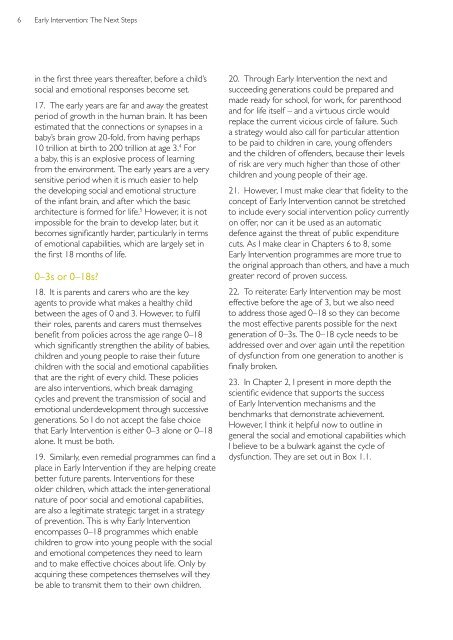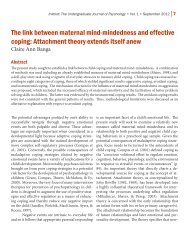early-intervention-next-steps
early-intervention-next-steps
early-intervention-next-steps
You also want an ePaper? Increase the reach of your titles
YUMPU automatically turns print PDFs into web optimized ePapers that Google loves.
6 Early Intervention: The Next Steps<br />
in the frst three years thereafter, before a child’s<br />
social and emotional responses become set.<br />
17. The <strong>early</strong> years are far and away the greatest<br />
period of growth in the human brain. It has been<br />
estimated that the connections or synapses in a<br />
baby’s brain grow 20-fold, from having perhaps<br />
10 trillion at birth to 200 trillion at age 3. 4 For<br />
a baby, this is an explosive process of learning<br />
from the environment. The <strong>early</strong> years are a very<br />
sensitive period when it is much easier to help<br />
the developing social and emotional structure<br />
of the infant brain, and after which the basic<br />
architecture is formed for life. 5 However, it is not<br />
impossible for the brain to develop later, but it<br />
becomes signifcantly harder, particularly in terms<br />
of emotional capabilities, which are largely set in<br />
the frst 18 months of life.<br />
0–3s or 0–18s?<br />
18. It is parents and carers who are the key<br />
agents to provide what makes a healthy child<br />
between the ages of 0 and 3. However, to fulfl<br />
their roles, parents and carers must themselves<br />
beneft from policies across the age range 0–18<br />
which signifcantly strengthen the ability of babies,<br />
children and young people to raise their future<br />
children with the social and emotional capabilities<br />
that are the right of every child. These policies<br />
are also <strong>intervention</strong>s, which break damaging<br />
cycles and prevent the transmission of social and<br />
emotional underdevelopment through successive<br />
generations. So I do not accept the false choice<br />
that Early Intervention is either 0–3 alone or 0–18<br />
alone. It must be both.<br />
19. Similarly, even remedial programmes can fnd a<br />
place in Early Intervention if they are helping create<br />
better future parents. Interventions for these<br />
older children, which attack the inter-generational<br />
nature of poor social and emotional capabilities,<br />
are also a legitimate strategic target in a strategy<br />
of prevention. This is why Early Intervention<br />
encompasses 0–18 programmes which enable<br />
children to grow into young people with the social<br />
and emotional competences they need to learn<br />
and to make efective choices about life. Only by<br />
acquiring these competences themselves will they<br />
be able to transmit them to their own children.<br />
20. Through Early Intervention the <strong>next</strong> and<br />
succeeding generations could be prepared and<br />
made ready for school, for work, for parenthood<br />
and for life itself – and a virtuous circle would<br />
replace the current vicious circle of failure. Such<br />
a strategy would also call for particular attention<br />
to be paid to children in care, young ofenders<br />
and the children of ofenders, because their levels<br />
of risk are very much higher than those of other<br />
children and young people of their age.<br />
21. However, I must make clear that fdelity to the<br />
concept of Early Intervention cannot be stretched<br />
to include every social <strong>intervention</strong> policy currently<br />
on ofer, nor can it be used as an automatic<br />
defence against the threat of public expenditure<br />
cuts. As I make clear in Chapters 6 to 8, some<br />
Early Intervention programmes are more true to<br />
the original approach than others, and have a much<br />
greater record of proven success.<br />
22. To reiterate: Early Intervention may be most<br />
efective before the age of 3, but we also need<br />
to address those aged 0–18 so they can become<br />
the most efective parents possible for the <strong>next</strong><br />
generation of 0–3s. The 0–18 cycle needs to be<br />
addressed over and over again until the repetition<br />
of dysfunction from one generation to another is<br />
fnally broken.<br />
23. In Chapter 2, I present in more depth the<br />
scientifc evidence that supports the success<br />
of Early Intervention mechanisms and the<br />
benchmarks that demonstrate achievement.<br />
However, I think it helpful now to outline in<br />
general the social and emotional capabilities which<br />
I believe to be a bulwark against the cycle of<br />
dysfunction. They are set out in Box 1.1.



